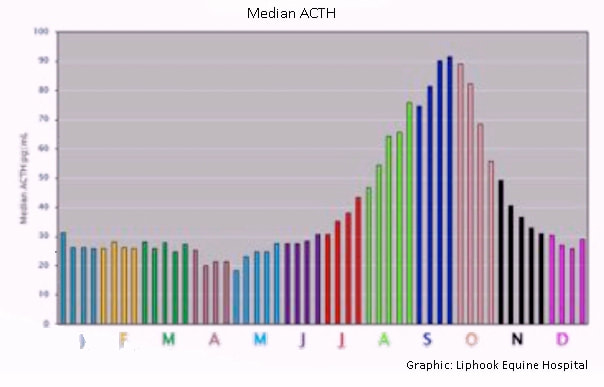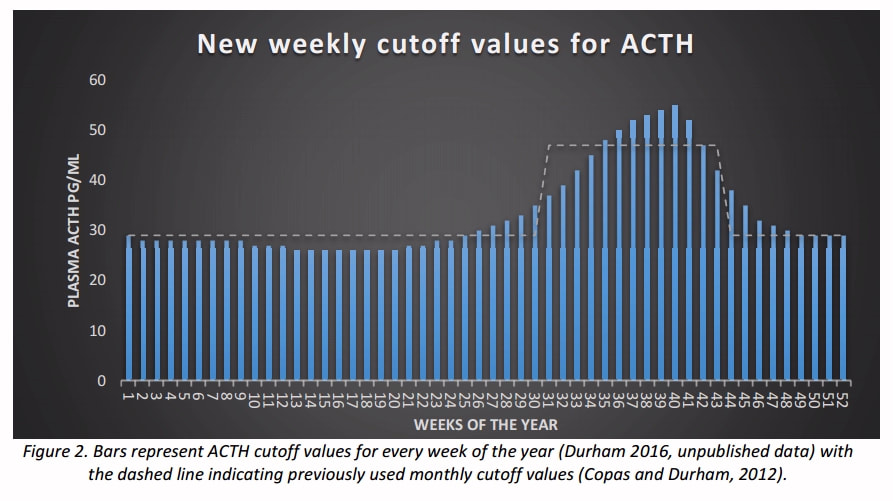Until recently it was suggested that 2 reference ranges should be used to take account of the "seasonal rise" or increase in ACTH between August and October - 47 pg/ml was recommended for the period August to October, and 29 pg/ml the rest of the year. However, it was recognised that the cut-off was not really going to leap from 29 pg/ml on 31 July to 47 pg/ml on 01 August, and vice versa between 31 October and 01 November. It has also recently been recognised that the seasonal rise seems to start around the June solstice, and finish by the December solstice, peaking around the September equinox. After studying thousands of ACTH results, Liphook are now recommending that weekly reference ranges should be used for diagnosing PPID - see Seasonal Changes in ACTH Secretion - A E Durham, Liphook Equine Hospital 2016 (and graph below for weekly cut-offs). Liphook use Immulite for their ACTH assay.
A single cut-off value is likely to be unrealistic (i.e. it is unlikely that a horse will definitely be negative for PPID with an ACTH below the suggested cut-off, and positive for PPID with an ACTH above the suggested cut-off), and therefore some interpretation of the blood test results is likely to be required. Before weekly reference ranges were suggested, when the cut-off from November to July was suggested to be 29 pg/ml, research by David Rendle et al. suggested that horses with ACTH below 19 pg/ml were unlikely to have PPID, and horses with ACTH over 40 pg/ml were likely to have PPID, but that "results of the current study indicate that when an ACTH concentration between 19 and 40 pg/ml is measured, further testing should be considered to increase the accuracy of PPID diagnosis." A similar grey area may exist around all suggested cut-offs when interpreting ACTH results for diagnosis of PPID.
Rendle DI, Litchfield E, Heller J, Hughes K J
Investigation of rhythms of secretion and repeatability of plasma adrenocorticotropic hormone concentrations in healthy horses and horses with pituitary pars intermedia dysfunction
Equine Veterinary Journal Vol 46, Issue 1, pages 113–117, January 2014 (published online Aug 2013)
Other laboratories suggest different cut-offs for diagnosing PPID, particularly during the seasonal rise. Cornell AHDC suggests that "Seasonal elevation of ACTH levels occurs from approximately mid-August to mid-October. Samples taken during this time period may have up to 3 times reference levels of ACTH in normal horses." Their normal cut-off is 35 pg/ml (outside of the seasonal rise), therefore up to 3 times this might mean an ACTH of up to 105 pg/ml might be considered negative for PPID between August and October. Cornell use Immulite for their ACTH assays.
The assay used by the laboratory will affect results and cut-offs. Immulite is a chemiluminescent Immunoassay (CIA), and much of the research into PPID uses Immulite, so this may be considered the industry standard. However, some laboratories use radio immunoassay (RIA). RIA ACTH results and cut-offs will be higher than CIA. In an article for Vet Times by David Rendle in 2012, the upper reference range for ACTH measured by CIA outside of the seasonal rise was suggested as 35 pg/ml, compared to 45-50 pg/ml for RIA - see Identifying Horses with PPID - Part 2: Interpreting Results.
Research by Banse et al 2018 suggested that CIA and RIA should not be used interchangeably for measurement of equine ACTH.
Banse HE, Schultz N, McCue M, Geor R, McFarlane D
Comparison of two methods for measurement of equine adrenocorticotropin
J Vet Diagn Invest. 2018 Mar;30(2):233-237. doi: 10.1177/1040638717752216. Epub 2017 Dec 28 (PubMed)
It is essential that the effect of stress and other factors that can raise ACTH produced as part of a normal stress response from the pars distalis can be eliminated when interpreting ACTH for a diagnosis of PPID, as commercial tests do not differentiate between pars distalis ACTH (normal stress response) and pars intermedia ACTH (due to PPID). See Does a high ACTH result mean my horse has PPID?
Age may affect the cut-off for diagnosis of PPID. Horses aged 20 and older, confirmed free of PPID at post mortem, had an average ACTH of 26.4 pg/ml with ACTH results up to 50 pg/ml (CIA), between November and July, suggesting that "A resting plasma ACTH concentration < 50 pg/ml would be considered normal in aged horses", according to this study. However, the horses were due to be euthanized, so health status may have affected results, and other factors such as geographical location and breed may have an influence. See
Dianne McFarlane
Establishment of a Reference Interval for Plasma ACTH Concentration in Aged Horses Dianne McFarlane
p 18 Equine Endocrinology Summit 2017
Clinical signs of PPID must be present for a diagnosis of PPID to be made. In her webinar Is it PPID or is it EMS? Dianne McFarlane suggested that history and clinical signs are essential for an early diagnosis of PPID, and that a diagnosis should not be made on the basis of diagnostic test results if there are no clinical signs.
For more information about PPID and diagnosis, see:
Pituitary Pars Intermedia Dysfunction
Recommendations for the Diagnosis and Treatment of Pituitary Pars Intermedia Dysfunction (PPID) 2015



 RSS Feed
RSS Feed